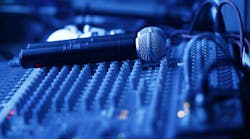This column will explore what electrical apprentices need to know when it comes to Art. 640, Audio Signal Processing, Amplification, and Reproduction Equipment. Found in Chapter 6 of the National Electrical Code (Special Equipment), this Article addresses nontypical applications or specialized areas of work/installations, such as electric signs, office furnishings, pipe organs, photovoltaic systems, escalators, elevators, etc.
Art. 640 covers equipment and wiring (permanent and temporary) for:
- Public address systems
- Speech input systems
- Distribution of sound
- Electronic musical instruments
- Temporary audio system installations
- Audio signal generation, recording, processing, amplification, and reproduction
It also addresses special occupancies or locations that use both portable and permanent installations, such as restaurants, hotels, business offices, commercial and retail sales environments, churches, schools, residences, auditoriums, theaters, stadiums, movie and television studios, auditoriums, theaters, stadiums, and outdoor events (e.g., fairs, festivals, circuses, public events, and concerts).
Within the guidance of Art. 640, pieces of equipment that are connected to sound systems can include, but are not limited to loudspeakers; headphones; pre-amplifiers; microphones and their power supplies; mixers; MIDI (musical instrument digital interface) equipment or other digital control systems; equalizers, compressors, and other audio signal processing equipment; and audio media recording and playback equipment, including turntables, tape decks and disk players (audio and multimedia), synthesizers, tone generators, and electronic organs.
Electronic organs and synthesizers may have integral or separate amplification and loudspeakers except for amplifier outputs; virtually all such equipment is used to process signals (analog or digital techniques) that have nonhazardous voltage levels or current.
Related Articles
When it comes to applying the requirements of Art. 640, be prepared to do your research. This Article may be modified or supplemented by the following Articles:
- Art. 518, Assembly Occupancies
- Art. 517, Health Care Facilities, Part VI
- Art. 525, Carnivals, Circuses, Fairs, and Similar Events
- Art. 530, Motion Picture and Television Studios and Similar Locations
- Art. 520, Theaters, Audience Areas of Motion Picture and Television Studios, Performance Areas, and Similar Locations
Putting it all together
No matter how small or large the application is, use these practices and methods wherever you work. Electricians must meet the guidelines required to protect persons and property — Art. 90.1 (A). The Code also requires us to provide the customer with a neat, organized installation; in other words, don't create a "bird’s nest" of wiring. Art. 640.6, Mechanical Execution of Work, requires us to install all audio cables so that the audio distribution cables will not be damaged by everyday building use. Cables installed on an exposed surface of ceilings and sidewalls shall be supported or secured by:
- Cables
- Straps
- Staples
- Cable ties
- Hangers
- Similar fittings that will not damage the cable
Safety first
Make safety a priority for your installation in the common and staff areas. Flexible cords and cables accessible to the public that are laid or run on the ground or floor shall be covered with approved nonconductive mats, as noted in Art. 640.45 (A), Protection of Wiring. In addition, your work should not present a tripping hazard. An accumulation of wires and cables should not prevent the removal of panels and suspended ceiling panel access, as described in Art. 640.5, Access to Electrical Equipment Behind Panels Designed to Allow Access.
If your installation is by a body of water, pool, spa, hot tub, or fountain, the branch-circuit power shall not be placed horizontally within 5 ft of the inside wall or within 5 ft of the prevailing or tidal high-water mark. The equipment shall be protected by a ground-fault circuit interrupter branch-circuit, as explained in Art. 640.10, Audio Systems Near Bodies of Water.
Wiring permanent installations
When wiring to and between audio equipment, the same requirements of Chapters 1 through 4, except as modified by this Article, apply when wiring from a power source to and between devices connected to the building wiring systems, as noted in Art. 640.9 (1). Cables used to connect loudspeakers or to an amplifier shall comply with Art. 725, Class 1, Class 2, and Class 3 Remote-Control, Signaling, and Power-Limited Circuits. The additional listed cable types are signal, hybrid communications, and composite optical fiber cables.
Flexible cords and cables shall be permitted for permanently installed equipment racks to the premises' wiring system. The connection shall be made either by using approved plugs and receptacles or by direct connection within an approved enclosure, as noted in Art. 640.21 (B). Flexible cords and cables shall not be subjected to abuse while the rack is in use. Installation of flexible cords and cables used to connect loudspeakers or an amplifier shall be listed for portable use, either hard or extra-hard usage. The cables must comply with Part I of Art. 400 and Parts I, II, III, and IV of Art. 725 640.42 (B).
As you continue your journey to understand the NEC's layout and structure, always remember that the NEC only sets the minimum guidelines for installation — so be prepared to do more if required by your local Authority Having Jurisdiction.
Follow my column for more practical how-to articles and tips for applying electric basics concepts in the field (Everyday Instructions for Electricians, Introduction to Commercial Service Calculations, Introduction to Residential Service Calculations, The Apprentice’s Guide to Non-Metallic Sheathed Cable, The Apprentice’s Guide to NEC Chapter 4, and The Apprentice’s Guide to Art. 300). For more information on why a structured approach is so important to navigating the NEC and how to put its requirements into practice in real-world settings, read “The NEC for Newbies.”
Harold De Loach, a master electrician and electrical trainer/instructor, is the founder of The Academy of Industrial Arts (www.taia-school.com) in Philadelphia. With more than 30 years of experience in the field, he writes regular exclusive content for the E-Train and can be reached at [email protected].




